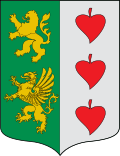Morga | |
|---|---|
 Town hall | |
 | |
| Coordinates: 43°17′0″N2°45′0″W / 43.28333°N 2.75000°W | |
| Country | |
| Autonomous community | |
| Province | Biscay |
| Comarca | Busturialdea |
| Government | |
| • Mayor | Arkaitz Villa Olea |
| Area | |
• Total | 17.6 km2 (6.8 sq mi) |
| Elevation | 205 m (673 ft) |
| Population (2018) [1] | |
• Total | 423 |
| • Density | 24/km2 (62/sq mi) |
| Demonym | Morgatarra |
| Time zone | UTC+1 (CET) |
| • Summer (DST) | UTC+2 (CEST) |
| Postal code | 48115 |
| Website | Official website |
Morga is a municipality located in the province of Biscay, in the autonomous community of Basque Country, northern Spain.




